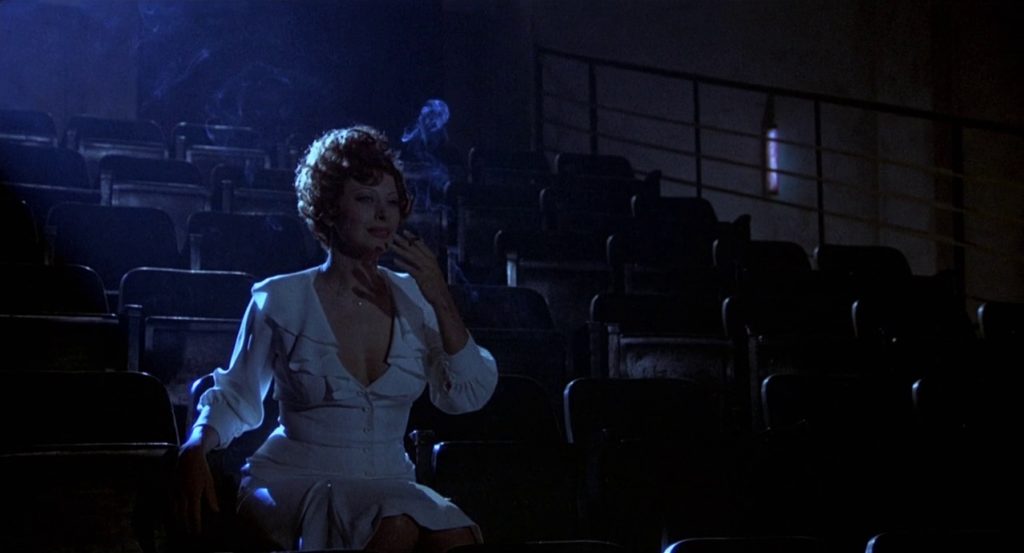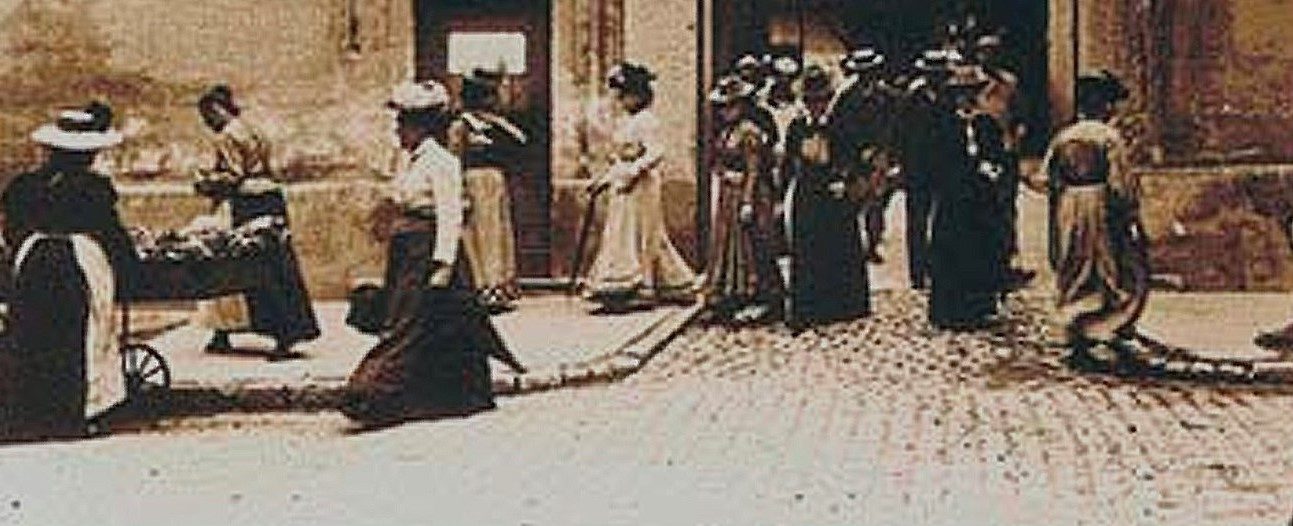Italy, France, 1973
Directed by Federico Fellini
With Magali Noël (Gradisca), Bruno Zanin (Titta), Armando Brancia (Aurelio), Pupella Maggio (Miranda), Ciccio Ingrassia (Teo), Josiane Tanzelli (La Volpina), Maria Antonietta Beluzzi (the tabacoonist), Luigi Rossi (the historian), Gianfilippo Carcano (Don Balosa)

“Amarcord” is a crowd. From the start, people are teeming the streets and rushing through the squares of the Romagna’s village where the film takes place, celebrating events and attending shows, sowing mayhem in a classroom or turning into a shouting match a family lunch, an ensemble cast filling the screen and making the camera roving around and capturing group portraits in a wide frame, but also a collection of mugs, striking, bizarre, even ugly faces, freakish or unbelievable physiognomies whose peculiarities extend to the whole body in a gathering of gleeful grotesques. They take part to variegated dramatic events which are heaped one after another along a vague timeline seemingly following the seasons of a year but also alternate with shorter and more intimate scenes featuring a handful.
The kind of narrative loosely holding the film together tends to revolve around a nucleus of characters, an archetypal Italian family: Titta, the mischievous, teenage eldest son, Aurelio, his hot-tempered father always picking a fight with his relatives and opposed to the regime of Benito Mussolini, Miranda, his histrionic and ever worrying mother, Teo, his mad uncle and completing the group a naughty younger brother who barely features, a doting grandpa who is always joking and farting and a gentle maid with rotund forms. Titta is also part of a bunch of misbehaving kids of the local secondary school whose antics yield hilarious vignettes.
The film can be seen as a coming-of-age tale. Beginning with a pagan rite welcoming a new spring, it deals with Titta’s obsession, shared by his fellow teenagers but also agitating older men, with carnal desire. Titta and the male contingent of the village are riveted to the bodies of women, spring heralding the need to have pleasure and to reproduce (though babies are pictured), the urge for sex pointing to the threshold the youngest must cross to become true men (a time when masturbation, vigorously highlighted by the movie, is an irrepressible need that calls for even more pleasure). The camera gaily shares the leering gaze of these males, unashamedly focusing on the round, prominent shapes of women’s bottoms and breasts.
Three of them stand as powerful symbols: la Volpina, a clearly wild, insane and lustful young woman living on the fringe of the village, the tobacconist, a sour shopkeeper with amazingly buxom breasts and Gradisca. This smart woman, always dressed in red or white, graciously and confidently walks across the place and the story, a riveting and racy beauty men hail and Titta secretly loves. More than the two other more common and approachable sex symbols she is a distant prize to earn and an ideal worth fighting for; she has also an ethereal quality that transcends her otherwise earthy instincts and attitudes.
The story of Titta and his close circle is also a portrait of a bygone era defined by competing moral authorities. If the Catholic church looks like a solid pillar of the community nobody could ignore, the film’s start makes clear other beliefs from ancient ages and rooted in the intimate bond with nature still matter to the village’s identity. The local priest, Don Balosa, remains an overwhelming figure, the indispensable partner for key moments of human life and death but is ruthlessly mocked by Titta and the narrative, a pathetic and inefficient figure. Rites seem to be attended out of decency and habits but it is not clear how sincere people are – anyway, teenagers clearly are not true believers.
Religious and pagan ideas have found a political competitor: the film shows the spectacular and pompous rallies the Fascist regime has invented to bring the nation together behind its leader (an official is proud to claim, even though it seems absurd, that 99 percent of the villagers are member of the ruling party). The humiliation suffered by Aurelio at the hands of the regime’s henchmen reminds the audience that this was a really tough and sinister dictatorship, not just a tinpot government showing off grandiose and inept ideals and policies. But the film rather emphasizes the overreaching and ridiculous pretensions of the regime and questions how deeply the people was really committed to it; at the same time the national pride it stoked is rightly acknowledged (the night when the crowd row deep into the sea to hail the famous Rex liner).
The film’s end is the end of a wonderful time. The funeral of Miranda and the wedding of Gradisca mean Titta loses a cherished parent, far more benevolent than the father and defining the daily routines of life at home, and nearly at the same time the symbol of sensuality and sentiment. He stands stupefied in the church but is invisible during the lunch celebrating the newly-weds: Titta’s world is no longer the same as maternal feelings and sexual fantasy have been carried away. What could be left is the memory of them.
“Amarcord” indeed means “I remember” in the Romagna’s dialect. The linguistic element and geography obviously suggest the film is based on memories of Federico Fellini, furthering the memory’s efforts shaping “I Vitelloni” (1953), Titta representing a new surrogate to the director after the part of Marcello Mastroianni in “8½” (1963). Fellini readily denied the connections.
The trouble does not lie so much in any factual truth but in the realistic possibility the film could offer. And does not: from that very inaugural night onwards it presents an eerie imagery subtly undercutting any notion of a naturalistic and scrupulous reconstruction. Tellingly, the only character that pretends to put some order in the village’s narrative, even to put it into rational perspective, relying on history and common sense, a distinguished mustachioed middle-aged fan of bike, is right away ridiculed by farts and whistles and his speech would feel out of touch with the scenes, when it is not contradicted by the memories of others the camera hastens to shoot (this is the amazing anecdote of the delicacy peddler who makes love with all the members of the harem of a visiting emir – the village is also a seaside resort not unlike Fellini’s Rimini). The narrative follows other rules than a straightforward relation – by the way, the one who is supposed to be remembering, Titta, is not the first to appear and nor does his voice play a key role in the development.
Back to these incredible physiognomies, bodies, attitudes that are redolent of more recent productions, like “Fellini – Satyricon” (1970): they have such an outré nature, seem so improbable and in the case of the ladies appear so clearly as illustrations of men’s trashiest sexual dreams that it is hard to believe they have really existed. And the actors playing the high school’ pupils look a bit too old to be fully convincing. The strange biker whose motorbike regularly zips through the place in an odd leitmotif, and whose identity remains unknown, adds to the sentiment that fantasy shapes as much as real perceptions these memories and that poetic or downright bizarre flourishes matter more than speech to organize the film.
When Titta narrates how he managed to get closer to Gradisca in a movie theater where they were the two only ones attending the screening, not only he sounds too lucky to be true but the way the film shots and edits his moves across the rows of seats, highlights the odd, unreal pose stricken by the woman and wraps all the sequence in a foggy, bluish, mysterious light point to an event that may be based on facts but is distorted by desire and distance. Not only characters and incidents: a magnificent work on cinematography turns the story into a powerful and endearing illusion, from the wintry days when Titta and Gradisca miss to meet each other in a maze dug out of heaps of snow to the dusty, golden summer day when Teo climbs on a tree out of folly (and sexual urge).
Memories, this loosely attached series of sequences may well be; but they are dealt with by the fantasies of a grown-up artist rather than the intellect of a writer. Fellini is right: he does not tell his story, not the way he suggested it in “I Vitelloni”; it would be impossible, anyway, as the director has severed all bonds with his neorealist roots and ordinary storytelling and narrative tropes. The life of the mind, the free association of images and ideas, the translation into new lights, compositions, acting of deeper visual demands that seek the truth of the sensation and not the realism of the fact – and indeed, the sea and the hotel’s rooms in “Amarcord” do look like gross imitation and gleeful fake outrageously jerry-built on the set – yes, all these purposes that have been preoccupying Fellini for years drive the directorial effort to turn past into something bigger and dreamier. Distortion leads to an emotional vibrancy and a sort of authenticity.
This is a reconstruction assuming the role of a reinvention and stirred by men’s most intimate sentiments and desires as well as by a nostalgia for big, collective adventures – bonfires, celebrations or just kids hanging around to feel adults. An implausible and magical reality is shaped to pay tribute to a teenager’s distant experience. If the young Fellini is not the topic, truth is that the imagination and vision of the older one has taken the center stage: the story exists as a powerful, riveting, deeply unique work by Fellini – who has put his own mind in front of the camera and delivers greater moving pictures than any look at reality.

